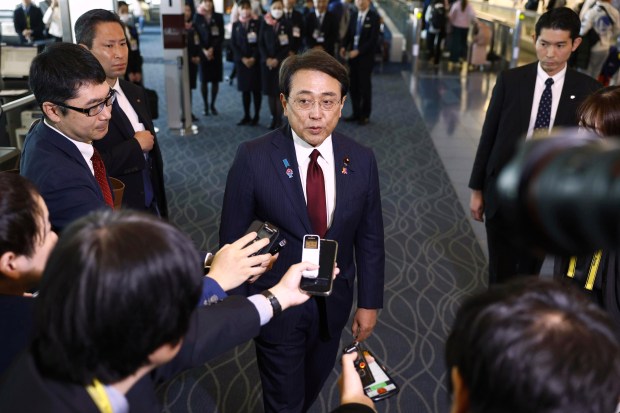President Trump was set to personally attend a meeting of Japanese and American trade officials on Wednesday, a surprise move that is raising hopes he could be willing to ease the mushrooming trade war sparked by his tariffs on imports.
Trump said he planned to discuss a wide range of issues at the sit-down that will include Treasury Secretary Scott Bessent and Commerce Secretary Howard Lutnick.
“Hopefully something can be worked out which is good (GREAT!) for Japan and the USA!” he wrote on his social media site.
Trump’s move to get directly involved in negotiations suggests he may hope to quickly finalize trade agreements.
It’s a big test of Trump’s reputation as a dealmaker as countries around the world seek to limit the damage unleashed by his trade war, which has sent Wall Street plunging and shaken global faith in U.S. economic stability.
The move came as Federal Reserve Chairman Jerome Powell said Trump’s tariffs would have a major negative impact on the U.S. economy, downbeat remarks that sent stocks sharply lower in afternoon trading.
Japan charges a relatively low average tax rate of 1.9% on other countries’ goods and has a longstanding economic and political alliance with the U.S., making it a potential prime candidate for a deal.
 Japan’s chief trade negotiator and Economic Revitalization Minister Ryosei Akazawa, center, speaks to the reporters before this departure for the U.S., at Haneda airport in Tokyo, Wednesday. (Kyodo News via AP)
Japan’s chief trade negotiator and Economic Revitalization Minister Ryosei Akazawa, center, speaks to the reporters before this departure for the U.S., at Haneda airport in Tokyo, Wednesday. (Kyodo News via AP)
Signs of progress with Japan in rolling back the steep tariffs — 10% on virtually all imports and 25% on imported cars — would likely be welcome by global markets because it could lead to more deals.
Trump also slapped an additional 24% tariff on imports from Japan as part of his “Liberation Day” trade war announcement. That ill-defined tariff has been paused for 90 days to allow for negotiations with all trading partners except for China.
The White House hasn’t said exactly what concessions it wants foreign trading partners like Japan to make.
It is seeking to close the $68.5 billion annual trade deficit with Japan and seeking greater access for U.S. goods. But Trump has also boasted that revenue from tariffs could be an ongoing revenue stream to pay down the federal budget deficit.
Trump has indicated that he also wants to discuss how much Japan contributes to the cost of U.S. troops stationed there, largely as a deterrent to China.
Japan aims to increase annual defense spending to nearly $10 trillion, or 2% of GDP, in 2027, while Trump wants Tokyo to spend more.
China has been hit with a blanket 145% tariff, although Trump later exempted popular electronic products like cellphones and laptops, saying Apple CEO Tim Cook had pleaded for a break.
China is trying to capitalize on the turmoil sparked by Trump’s announcements, with President Xi Jinping touting the manufacturing powerhouse as a more reliable trade partner than the U.S. in a diplomatic tour of southeast Asia.
